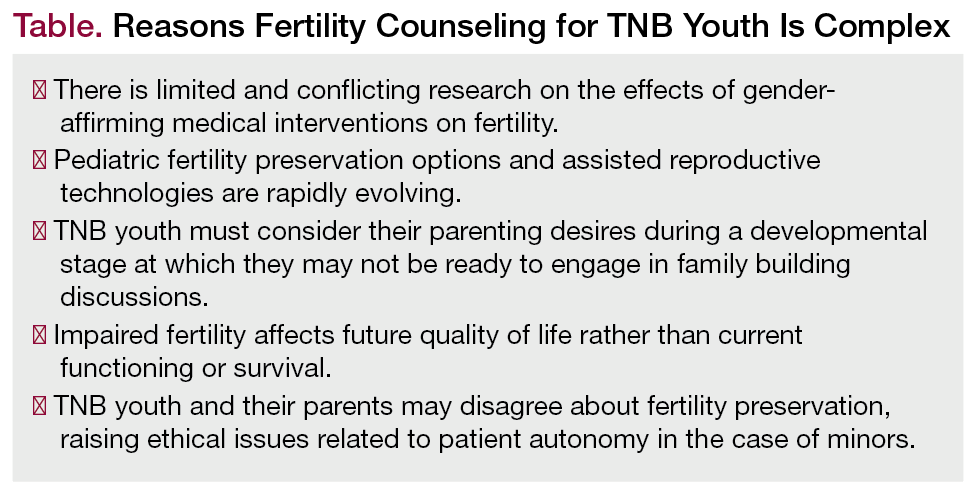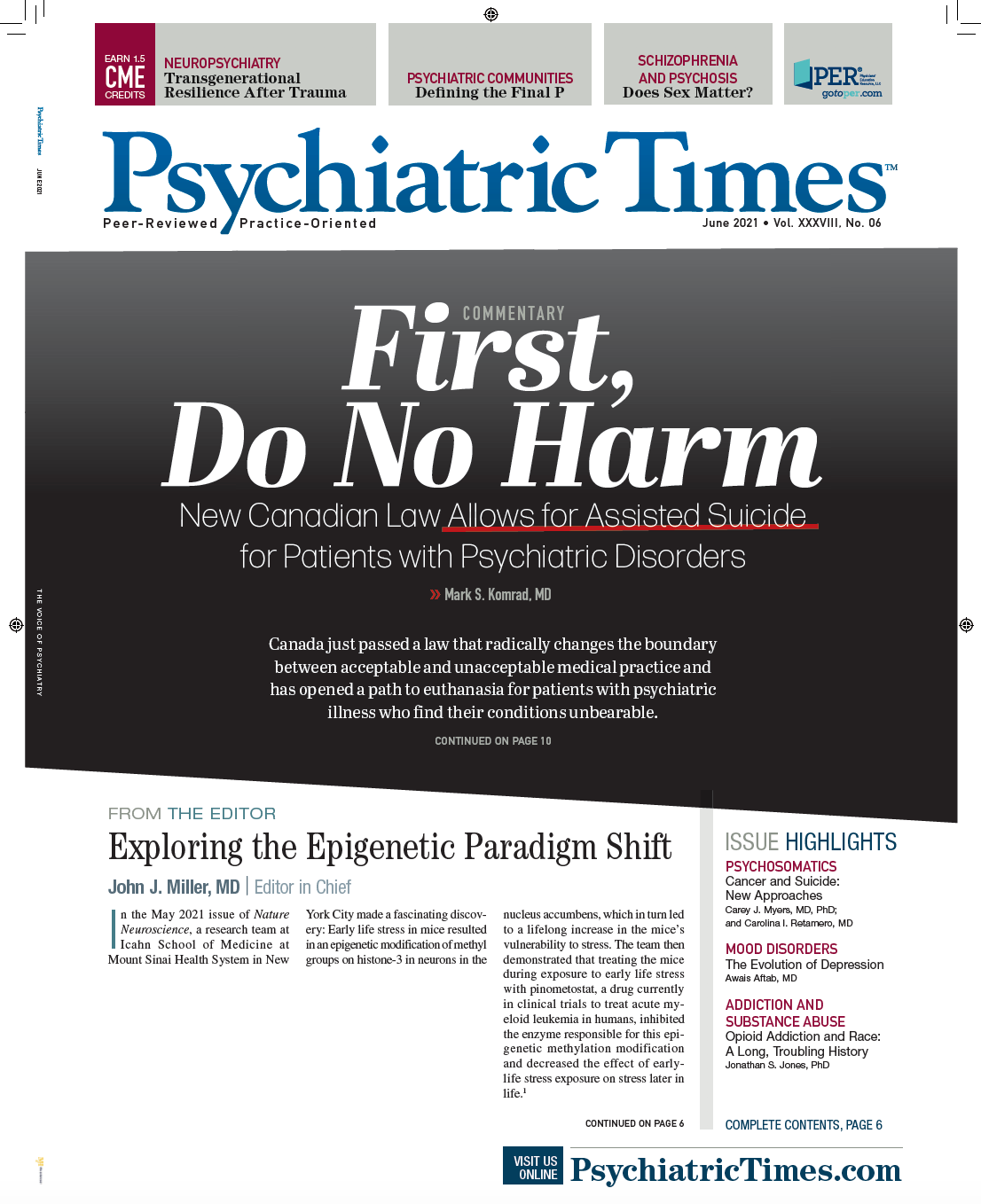ALSO IN THIS SPECIAL REPORT
The Trauma-Focused CBT and Family Acceptance Project: An Integrated Framework for Children and Youth
Judith A. Cohen, MD; Caitlin Ryan, PhD, ACSW
Publication
Article
Psychiatric Times
Author(s):
Psychiatrists should discuss fertility with TNB youth during medical and mental health visits—early and often.
NadyaEugene/shutterstock

SPECIAL REPORT: SEXUAL AND GENDER MINORITIES PART 2
Fertility considerations in the context of gender-affirming medical care for transgender and nonbinary (TNB) youth have garnered increasing attention in recent years, given the potential for treatments affecting fertility and the expanding availability of fertility preservation interventions.1,2 The World Professional Association for Transgender Health and the Endocrine Society recommend fertility counseling, including discussions about fertility preservation, as part of the informed consent process for treatment with pubertal suppression and gender-affirming hormones (GAH).3,4 Despite these recommendations, there is little direct guidance about fertility counseling for clinicians. Reported rates of fertility preservation among TNB youth in the United States remains low, ranging from 2.7% to 4.7%, in contrast to relatively higher rates of TNB youth reporting the desire to have genetically related children (24%-36%).5-9
The Trauma-Focused CBT and Family Acceptance Project: An Integrated Framework for Children and Youth
Judith A. Cohen, MD; Caitlin Ryan, PhD, ACSW
There is no consensus among TNB youth and their families regarding who is best positioned to provide fertility counseling in the context of initiating gender-affirming medical interventions.10 In one study, many families identified the physician prescribing hormones as potentially the most knowledgeable about the effects of puberty suppression and GAH on fertility, but mental health clinicians were also highlighted as key individuals who can help TNB youth explore their attitudes and values related to fertility and family planning and support youth and their families in treatment decision-making.10
Given that interdisciplinary care, including mental health clinicians, is recommended for TNB minors seeking gender-affirming medical interventions, psychiatrists and other mental health clinicians are uniquely positioned to participate in the fertility counseling process. Yet, many mental health clinicians report they lack an understanding of the fertility implications of gender-affirming hormonal care, which interferes with their ability to effectively counsel their patients.11,12
Pubertal Suppression and Gender-Affirming Hormones
Gender-affirming medical interventions are offered to TNB youth based on their age, pubertal stage, and treatment goals. TNB youth in the early stages of puberty may be prescribed gonadotropin-releasing hormone analogues (GnRHa) for pubertal suppression. GnRHa prevent unwanted secondary sex characteristics by suspending pubertal development through suppression of the hypothalamic-pituitary-gonadal axis. This prevents endogenous gonadal sex hormone production. If GnRHa are discontinued, the hypothalamic-pituitary-gonadal axis reactivates, and endogenous puberty progresses.
GnRHa have been used in other populations (eg, children with precocious puberty) with no known fertility impairment. Pubertal development, however, is necessary for sperm production and egg maturation, and it is typically not until the later stages of puberty that mature sperm and eggs are present.2 Thus, TNB youth receiving GnRHa in early puberty, as recommended by current standards of care, will likely not have mature gametes at the time of GnRHa treatment initiation.3,4 This is important because the vast majority of TNB youth receiving pubertal suppression treatment do not discontinue treatment before starting GAH.13 There is no research examining long-term fertility outcomes in TNB individuals who are treated with GnRHa in early puberty and then go on to initiate GAH, and thus, do not progress in their endogenous puberty. In this population, clinicians cannot predict fertility potential, either naturally or with assisted reproductive technologies.
TNB adolescents presenting for care in later puberty may be prescribed GAH to induce secondary sex characteristics aligned with their gender identity, such as testosterone-mediated changes like facial hair and voice deepening and estrogen-mediated changes like breast development. Research on the effects of GAH on fertility in late pubertal or postpubertal TNB youth is mixed. Study results of transgender men treated with testosterone showed changes in ovarian histology, including stromal hyperplasia, increased collagenization, and morphology consistent with polycystic ovarian syndrome.1 However, implications of these changes on actual fertility and live birth rates are unclear. Case reports have shown transgender men (average age, 28.3 years ± 6.7 years) who discontinued testosterone treatment after an average of 44 months (SD = 31 months) prior to undergoing ovarian stimulation for egg retrieval had a similar number of oocytes retrieved compared with cisgender women.14 Furthermore, there are several reported cases of transgender men experiencing unplanned pregnancy while taking testosterone, suggesting that ovulation is possible even when menses is suppressed.15,16 Results from a recent case study also suggest ovarian stimulation for oocyte retrieval without discontinuing testosterone therapy may be possible.17
Research shows that estrogen exposure can impair spermatogenesis, although long-term studies in TNB populations have been limited. Among cisgender men, studies of estrogen-secreting tumors show that sperm production is possible after tumor removal, even months to years after abnormal hormone function, whereas results of studies of high-dose estrogen to treat prostate disease show associations with azoospermia and testicular atrophy, with variable reversibility.1 Research among transgender women has shown a reduction in testicular volumes and damage to sperm production after initiating estrogen therapy. However, it remains unclear whether these semen parameters improve after discontinuing estrogen.18,19
Fertility Preservation Interventions
A range of fertility preservation interventions is available to TNB individuals depending on designated sex at birth and pubertal stage.2 For TNB individuals designated male at birth, sperm cryopreservation is a safe, established, and cost-effective fertility preservation method. Although noninvasive retrieval methods are typically recommended (ie, masturbation), sperm may also be retrieved surgically among individuals for whom masturbation is not desired due to gender dysphoria.20 Oocyte and embryo cryopreservation are established options for postmenarcheal TNB individuals. Egg retrieval requires approximately 2 weeks of daily hormone injections to stimulate follicular development, transvaginal or abdominal ultrasounds monitoring, and transvaginal oocyte collection conducted under conscious sedation.
Mature gametes are not usually present before mid to late puberty. In cases in which fertility preservation may be desired before gamete maturation or when gamete maturation is not expected due to GnRHa treatment in early puberty, cryopreservation of immature gonadal tissue may be an option under an experimental institutional review board protocol. However, these options must be discussed carefully with families of minors, given that no live human births have been reported with testicular tissue, and removal of an ovary has implications for future fertility. Further, immature gonadal tissue cryopreservation with consecutive in vitro maturation has some demonstrated success in animal models but has yet to be proven in humans.
Case Vignette 1
“Peyton,” a 15-year-old transgender boy, presents to an interdisciplinary gender health clinic with his parents to discuss starting testosterone. Peyton experienced worsening gender dysphoria as he began menstruating. Peyton and his parents are well informed about the effects of testosterone, including that its effects on future fertility are somewhat unclear and understudied. During the clinic visit, the team introduces fertility preservation as an option. Peyton responds, “I’m not interested in preserving my fertility. I don’t think I want kids and I know I never want to be pregnant, so I’ll just adopt if I change my mind about kids in the future.”
Case Vignette 2
“Ashley,” a 16-year-old transgender girl, has received care at a gender health clinic for the past 6 months. She initiated care with her parents to discuss estrogen therapy for gender affirmation. Ashley’s parents have refused to consent for estrogen unless she agrees to complete sperm cryopreservation before starting hormones. Ashley tearfully shares with the team, “I just don’t think I can give a semen sample. I’m so uncomfortable in my body.”
Best Practices for Fertility Counseling
Fertility counseling for TNB youth is complex for a number of reasons (Table). To provide comprehensive fertility counseling across the treatment continuum, psychiatrists and other mental health clinicians caring for TNB youth must be aware of the known and unknown effects of gender-affirming medical interventions on fertility, various fertility preservation options, and new developments in reproductive technology.
Reasons Fertility Counseling for TNB Youth Is Complex

Given the known and unknown effects of pubertal suppression and GAH on fertility, counseling is recommended preceding treatment and. Because fertility preservation is possible even after starting gender-affirming medical interventions, counseling should continue on an ongoing basis thereafter. Initial counseling should focus on the effects of GnRHa on gametogenesis and the effects of GAH on fertility because most youth starting GnRHa progress on to GAH. Issues like the potential effects of hormones on fertility and the reversibility of any fertility impairment if hormones are discontinued should be discussed prior to initiating testosterone or estrogen. Because fertility impairment is not absolute with GAH, the need for contraception to prevent undesired pregnancy should also be highlighted. Importantly, TNB youth and families should be informed that there have been no prospective studies examining the effects of long-term (ie, started in adolescence) GAH use on fertility or in those treated with GnRHa in early puberty followed by GAH.
Counseling about fertility preservation should include a comprehensive discussion of what options exist; what each option entails (eg, potential risks, the process for obtaining mature gametes, what is needed to use preserved gametes in the future, cost); the timeframe for completing fertility preservation in the context of gender-affirming medical care; and how long GAH will need to be discontinued to pursue fertility preservation (which can be widely variable) in the case that someone has already started GAH. Potential risks and adverse effects may be physical (eg, ovarian hyperstimulation syndrome) or psychological (eg, potential worsening of gender dysphoria) in nature, and both are equally important to consider. Furthermore, it is important for TNB youth considering fertility preservation to understand the likelihood of a future live birth given the number of mature oocytes or amount of semen obtained, as completing fertility preservation does not guarantee genetically related children. Also, given research showing that over 50% of adult TNB individuals desire children, introducing the possibility that a youth’s current parenthood desires may change over time is also a crucial aspect of fertility counseling.1
Concluding Thoughts
In summary, fertility discussions should occur within medical and mental health visits with TNB youth, both early and ongoing. Psychiatrists and other mental health clinicians are uniquely positioned to counsel TNB youth and their families about fertility, with particular attention to developmental considerations, navigating complex discussions when parents and youth disagree, and future planning, including exploring the possibility of future infertility-related regret. Individual, family, and cultural factors should be considered, with the ultimate goal of empowering TNB youth to make informed decisions and minimize future regret.
Dr Chen is a pediatric psychologist in the Pritzker Department of Psychiatry and Behavioral Health and director of Behavioral Health in the Potocsnak Family Division of Adolescent & Young Adult Medicine at the Ann & Robert H. Lurie Children’s Hospital of Chicago. She is also associate professor of Psychiatry and Behavioral Sciences, and Pediatrics, at Northwestern University Feinberg School of Medicine. Dr Nahata is a pediatric endocrinologist at Nationwide Children’s Hospital and associate professor of Clinical Pediatrics at the Ohio State University College of Medicine. She is also principal investigator at the Center for Biobehavioral Health in the Abigail Wexner Research Institute.
References
1. Nahata L, Chen D, Moravek MB, et al. Understudied and under-reported: fertility issues in transgender youth-a narrative review. J Pediatr. 2019;205:265-271.
2. Finlayson C, Johnson EK, Chen D, et al. Proceedings of the working group session on fertility preservation for individuals with gender and sex diversity. Transgend Health. 2016;1(1):99-107.
3. Coleman E, Bockting W, Botzer M, et al. Standards of care for the health of transsexual, transgender, and gender-nonconforming people, version 7. Int J Transgend. 2012;13(4):165-232.
4. Hembree WC, Cohen-Kettenis PT, Gooren L, et al. Endocrine treatment of gender-dysphoric/gender-incongruent persons: an endocrine society clinical practice guideline. J Clin Endocrinol Metab. 2017;102(11):3869-3903.
5. Chen D, Simons L, Johnson EK, et al. Fertility preservation for transgender adolescents. J Adolesc Health. 2017;61(1):120-123.
6. Nahata L, Tishelman AC, Caltabellotta NM, Quinn GP. Low fertility preservation utilization among transgender youth. J Adolesc Health. 2017;61(1):40-44.
7. Wakefield BW, Boguszewski KE, Cheney D, Taylor JF. Patterns of fertility discussions and referrals for youth at an interdisciplinary gender clinic. LGBT Health. 2019;6(8):417-421.
8. Strang JF, Jarin J, Call D, et al. Transgender youth fertility attitudes questionnaire: measure development in nonautistic and autistic transgender youth and their parents. J Adolesc Health. 2018;62(2):128-135.
9. Chen D, Matson M, Macapagal K, et al. Attitudes toward fertility and reproductive health among transgender and gender-nonconforming adolescents. J Adolesc Health. 2018;63(1):62-68.
10. Quain KM, Kyweluk MA, Sajwani A, et al. Timing and delivery of fertility preservation information to transgender adolescents, young adults, and their parents. J Adolesc Health. 2021;68(3):619-622.
11. Chen D, Kolbuck VD, Sutter ME, et al. Knowledge, practice behaviors, and perceived barriers to fertility care among providers of transgender healthcare. J Adolesc Health. 2019;64(2):226-234.
12. Tishelman AC, Sutter ME, Chen D, et al. Health care provider perceptions of fertility preservation barriers and challenges with transgender patients and families: qualitative responses to an international survey. J Assist Reprod Genet. 2019;36(3):579-588.
13. Brik T, Vrouenraets LJJJ, de Vries MC, Hannema SE. Trajectories of adolescents treated with gonadotropin-releasing hormone analogues for gender dysphoria. Arch Sex Behav. 2020;49(7):2611-2618.
14. Leung A, Sakkas D, Pang S, et al N. Assisted reproductive technology outcomes in female-to-male transgender patients compared with cisgender patients: a new frontier in reproductive medicine. Fertil Steril. 2019;112(5):858-865.
15. Light A, Wang LF, Zeymo A, Gomez-Lobo V. Family planning and contraception use in transgender men. Contraception. 2018;98(4):266-269.
16. Light AD, Obedin-Maliver J, Sevelius JM, Kerns JL. Transgender men who experienced pregnancy after female-to-male gender transitioning. Obstet Gynecol. 2014;124(6):1120-1127.
17. Gale J, Magee B, Forsyth-Greig A, et al. Oocyte cryopreservation in a transgender man on long term testosterone therapy: a case report. F&S Reports. Published online February 20, 2021.
18. Barnard EP, Dhar CP, Rothenberg SS, et al. Fertility preservation outcomes in adolescent and young adult feminizing transgender patients. Pediatrics. 2019;144(3):e20183943.
19. Jiang DD, Swenson E, Mason M, et al. Effects of estrogen on spermatogenesis in transgender women. Urology. 2019;132:117-122.
20. Johnson EK, Finlayson C. Preservation of fertility potential for gender and sex diverse individuals. Transgend Health. 2016;1(1):41-44. ❒
